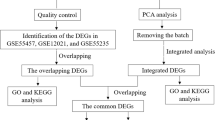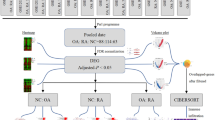Abstract
The purpose of this study was to employ microarray analysis to evaluate differential gene expression in synovial tissue samples obtained from patients with rheumatoid arthritis (RA) or osteoarthritis (OA) to study the expression profile of apoptosis-associated genes in these tissues. Four samples were obtained from RA-affected patients and three from osteoarthritis patients. After total RNA was extracted from synovial tissue, the RNA was processed using two-cycle target labeling, followed by hybridization and scanning procedure. The GeneChip Human Genome U133 Plus 2.0 containing 900471 gene loci was used and eight genes associated with apoptosis were identified with a selected p value <0.05 and a twofold change in expression in rheumatoid samples compared to osteoarthritis tissues. Anti-apoptotic genes were generally upregulated whereas apoptotic genes were downregulated suggesting that these genes may play a role in the pathogenesis of RA. Furthermore, these genes may serve as novel therapeutic targets for the treatment of RA.

Similar content being viewed by others
References
Gay S, Gay RE, Koopman WJ (1993) Molecular and cellular mechanism of joint destruction in rheumatoid arthritis: two cellar mechanisms explain joint destruction. Ann Rheum Dis 52:39–47
MacKenzie NM (2006) New therapeutics that treat rheumatoid arthritis by blocking T-cell activation. Drug Discov Today 11:952–956
Hui A, Kulkarni GV, Hunter WL, McCulloch CA, Cruz TF (1997) Paclitaxel selectively induces mitotic arrest and apoptosis in proliferating bovine synoviocytes. Arthritis Rheum 40:1073–1084
Nakajima T, Aono H, Hasunuma T, Yamamoto K, Shirai T, Hirohata K, Nishioka K (1995) Apoptosis and functional Fas antigen in rheumatoid arthritis synoviocytes. Arthritis Rheum 38:485–491
Ceponis A, Hietanen J, Tamulaitiene M, Partsch G, Pätiälä H, Konttinen YT (1999) A comparative quantitative morphometric study of cell apoptosis in synovial membranes in psoriatic, reactive and rheumatoid arthritis. Rheumatology (Oxford) 38:431–440
Kobayashi T, Okamoto K, Kobata T, Hasumuna T, Nishioka K (1999) Apomodulation as a novel therapeutic concept for the regulation of apoptosis in rheumatoid synoviocytes. Curr Opin Rheumatol 11:188–193
Wolfe F, Michaud K (2007) Resistance of rheumatoid arthritis patients to changing therapy: discordance between disease activity and patients’ treatment choices. Arthritis Rheum 56:2135–2142 [Epub ahead of print]
Bernatsky S, Hudson M, Suissa S (2007) Anti-rheumatic drug use and risk of serious infections in rheumatoid arthritis. Rheumatology (Oxford) 46:1157–1160
Buch MH, Bingham SJ, Bryer D, Emery P (2007) Long-term infliximab treatment in rheumatoid arthritis: subsequent outcome of initial responders. Rheumatology (Oxford) 46:1153–1156
Mountz JD, Wu J, Cheng H, Zhou T (1994) Autoimmune disease: a problem of defective apoptosis. Science 37:1415–1420
Ogawa N, Dang H, Hald N (1995) Apoptosis and autoimmunity. J Antoimmun 8:1–19
Firestein GS, Nguyen K, Aupperle KR, Yeo M, Boyle DL, Zvaifler NJ (1996) Apoptosis in rheumatoid arthritis: p53 overexpression in rheumatoid arthritis synovium. Am J Pathol 149:2143–2151
Triplett JW, Pavalko FM (2006) Disruption of alpha-actinin–integrin interactions at focal adhesions renders osteoblasts susceptible to apoptosis. Am J Physiol Cell Physiol 291:C909–C921
Sasaki S, Nakamura T, Arakawa H, Mori M, Watanabe T, Nagawa H, Croce CM (2002) Isolation and characterization of a novel gene, hRFI, preferentially expressed in esophageal cancer. Oncogene 21:5024–5030
Sasaki S, Watanabe T, Konishi T, Kitayama J, Nagawa H (2004) Effects of expression of hRFI on adenoma formation and tumor progression in colorectal adenoma––carcinoma sequence. J Exp Clin Cancer Res 23:507–512
Galvan V, Logvinova A, Sperandio S, Ichijo H, Bredesen DE (2003) Type 1 insulin-like growth factor receptor (IGF-IR) signaling inhibits apoptosis signal-regulating kinase 1 (ASK1). J Biol Chem 278:13325–13332
Zwerina J, Hayer S, Redlich K, Bobacz K, Kollias G, Smolen JS, Schett G (2006) Activation of p38 MAPK is a key step in tumor necrosis factor-mediated inflammatory bone destruction. Arthritis Rheum 54:463–472
Nakajima K, Hirose H, Taniguchi M, Kurashina H, Arasaki K, Nagahama M, Tani K, Yamamoto A, Tagaya M (2004) Involvement of BNIP1 in apoptosis and endoplasmic reticulum membrane fusion. EMBO J 23:3216–3226
Mishra S, Murphy LJ (2006) The p53 oncoprotein is a substrate for tissue transglutaminase kinase activity. Biochem Biophys Res Commun 339:726–730
Davila E, Kang YM, Park YW, Sawai H, He X, Pryshchep S, Goronzy JJ, Weyand CM (2005) Cell-based immunotherapy with suppressor CD8 + T cells in rheumatoid arthritis. J Immunol 174:7292–7301
Ehinger M, Vestberg M, Johansson AC, Johannesson M, Svensson A, Holmdahl R (2001) Influence of CD4 or CD8 deficiency on collagen-induced arthritis. J Immunol 103:291–300
Taneja V, Taneja N, Paisansinsup T, Behrens M, Griffiths M, Luthra H, David CS (2002) CD4 and CD8 T cells in susceptibility/protection to collagen-induced arthritis in HLA-DQ8-transgenic mice: implications for rheumatoid arthritis. J Immunol 168:5867–5875
Mohan K, Pinto D, Issekutz TB (2003) Identification of tissue transglutaminase as a novel molecule involved in human CD8+ T cell transendothelial migration. J Immunol 171:3179–3186
Fan Z, Beresford PJ, Zhang D, Xu Z, Novina CD, Yoshida A, Pommier Y, Lieberman J (2003) Cleaving the oxidative repair protein Ape1 enhances cell death mediated by granzyme A. Nat Immunol 4:106–108
Su HP, Nakada-Tsukui K, Tosello-Trampont AC, Li Y, Bu G, Henson PM, Ravichandran KS (2002) Interaction of CED-6/GULP, an adapter protein involved in engulfment of apoptotic cells with CED-1 and CD91/low density lipoprotein receptor-related protein (LRP). J Biol Chem 277:11772–11779
Sharfe N, Dadi HK, Shahar M, Roifman CM (1997) Human immune disorder arising from mutation of the alpha chain of the interleukin-2 receptor. Proc Natl Acad Sci USA 4:3168–3171
Acknowledgments
This work was supported by the Department of Medical Research of Guangzhou LiuHuaQiao Hospital, GeneTech Biotechnology Limited Company and a fund from Guangdong Province key technology research projects (No. 200434001010).
Author information
Authors and Affiliations
Corresponding author
Rights and permissions
About this article
Cite this article
Qingchun, H., Runyue, H., LiGang, J. et al. Comparison of the expression profile of apoptosis-associated genes in rheumatoid arthritis and osteoarthritis. Rheumatol Int 28, 697–701 (2008). https://doi.org/10.1007/s00296-008-0534-7
Received:
Accepted:
Published:
Issue Date:
DOI: https://doi.org/10.1007/s00296-008-0534-7




